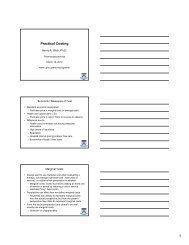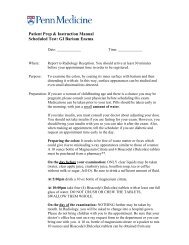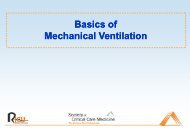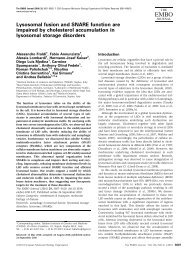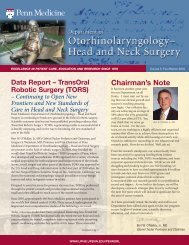Essentials of water treatment in hemodialysis - Penn Medicine
Essentials of water treatment in hemodialysis - Penn Medicine
Essentials of water treatment in hemodialysis - Penn Medicine
You also want an ePaper? Increase the reach of your titles
YUMPU automatically turns print PDFs into web optimized ePapers that Google loves.
Ahmad<br />
Table 2 Contam<strong>in</strong>ants <strong>in</strong> <strong>water</strong> and their toxic effects and maximum allowable concentrations<br />
Maximum<br />
Contam<strong>in</strong>ant Toxic effect concentration (mg/L)<br />
Alum<strong>in</strong>um<br />
Known to be toxic to dialysis patients<br />
Encephalopathy, bone disease, anemia < 0.01<br />
Chloram<strong>in</strong>es Hemolysis, anemia, methemoglob<strong>in</strong>emia < 0.10<br />
Chlor<strong>in</strong>e 0.5<br />
Copper Hemolysis, fever, headache, hepatitis < 0.10<br />
Fluoride Bone disease, osteomalacia < 0.20<br />
Nitrate Cyanosis, methemoglob<strong>in</strong>emia, hypotension, nausea < 2.0<br />
Sulfate Nausea, vomit<strong>in</strong>g, acidosis 100<br />
Z<strong>in</strong>c Anemia, nausea, vomit<strong>in</strong>g, fever<br />
Normally present <strong>in</strong> dialysate<br />
0.1<br />
Calcium Nausea, vomit<strong>in</strong>g, weakness, headache, hypertension, malaise, cardiac problems < 2 (0.1 mEq/L)<br />
Magnesium Nausea, vomit<strong>in</strong>g, weakness, headache, hypertension, malaise, cardiac problems < 4.0 (0.3 mEq/L)<br />
Potassium Muscle symptoms, bradyrrhythmia, death 8 (0.2 mEq/L)<br />
Sodium Hypertension, pulmonary edema, headache, thirst, confusion, seizure, coma<br />
Unsafe even <strong>in</strong> dr<strong>in</strong>k<strong>in</strong>g <strong>water</strong><br />
70 (3.0 mEq/L)<br />
Arsenic Nausea, vomit<strong>in</strong>g, diarrhea, hepatitis, polyneuropathy, sk<strong>in</strong> lesions 0.005<br />
Barium Hypokalemia 0.1<br />
Beryllium Pulmonary granulomatous disease with cough, weight loss 0.0004<br />
Cadmium Bone disease, renal disease 0.001<br />
Chromium Carc<strong>in</strong>ogen 0.014<br />
Lead Abdom<strong>in</strong>al pa<strong>in</strong>, neuropathy, nephropathy, encephalopathy, hypertension 0.005<br />
Mercury Tremors, g<strong>in</strong>givitis, psychiatric symptoms 0.0002<br />
Selenium Nausea, vomit<strong>in</strong>g, diarrhea 0.09<br />
Silver Vomit<strong>in</strong>g, diarrhea, shock, coma, convulsions, death 0.005<br />
Thallium Neuropathy 0.002<br />
RO or mixed-bed DI. The advantages and disadvantages<br />
<strong>of</strong> these two devices are listed <strong>in</strong> the Table 1. Some<br />
units use both devices, either <strong>in</strong> a series, less commonly,<br />
or more commonly, a DI as a back up for the reverse<br />
osmosis.<br />
Feed Water<br />
Ca & Mg Na<br />
Hard<br />
Figure 3 Water s<strong>of</strong>tener.<br />
Product Water<br />
S<strong>of</strong>t<br />
Na<br />
Water Conta<strong>in</strong><strong>in</strong>g<br />
Ca & Mg<br />
Na<br />
Ca Mg<br />
Res<strong>in</strong> Beads with Na<br />
Ca & Mg Exchanged with Na<br />
Product Water with Na<br />
(Ca Mg Removed)<br />
RO SYSTEM<br />
RO is the most cost-effective method for <strong>water</strong> purification<br />
from both organic and <strong>in</strong>organic solutes, <strong>in</strong>clud<strong>in</strong>g<br />
organisms and endotox<strong>in</strong>s. This is a filtration process <strong>of</strong><br />
<strong>water</strong> across a very tight membrane with ionic rejection <strong>of</strong><br />
90% to 99%. When <strong>water</strong> is filtered across this tight<br />
membrane, the filtered <strong>water</strong> is called ‘‘permeate’’ or<br />
‘‘RO <strong>water</strong>’’ and <strong>water</strong> conta<strong>in</strong><strong>in</strong>g rejected solutes and<br />
other substances is called ‘‘rejection,’’ ‘‘concentrate,’’ or<br />
‘‘br<strong>in</strong>e.’’ The osmolarity <strong>of</strong> br<strong>in</strong>e (conta<strong>in</strong><strong>in</strong>g solutes) is a<br />
lot higher than the osmolarity <strong>of</strong> permeate; normally the<br />
<strong>water</strong> would move from permeate to br<strong>in</strong>e because <strong>of</strong><br />
higher osmotic pressure. Enough mechanical force<br />
(hydraulic pressure) with a pump, however, is applied<br />
on the br<strong>in</strong>e side; <strong>water</strong> is thus forced (filtered) aga<strong>in</strong>st<br />
the osmolar force across the membrane. RO membranes<br />
are like dialyzer membranes except the pores are so small<br />
that they do not even allow any solute <strong>in</strong>clud<strong>in</strong>g Na or<br />
other ions and any organic matter (Figure 4). Three<br />
different types <strong>of</strong> membranes, cellulosic, synthetic, and<br />
th<strong>in</strong> composite membranes, similar to dialyzers, are fitted<br />
130 Hemodialysis International 2005; 9: 127–134







